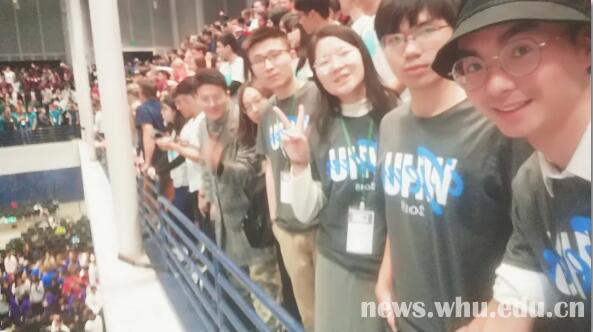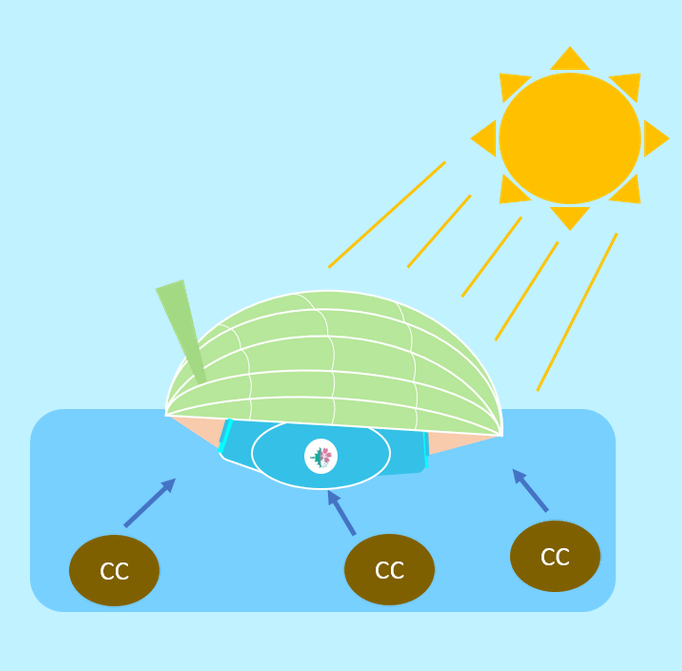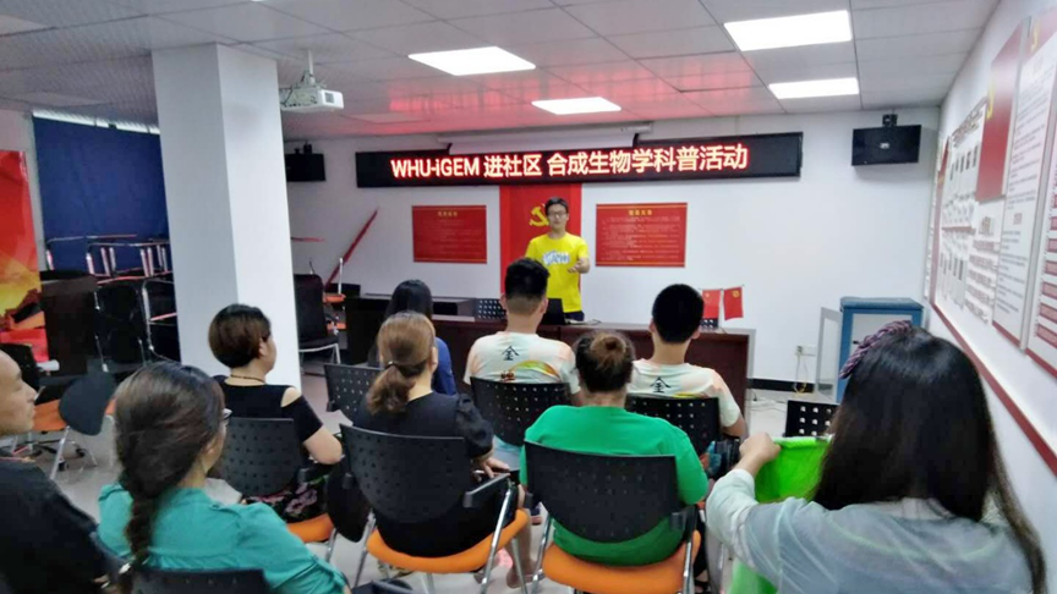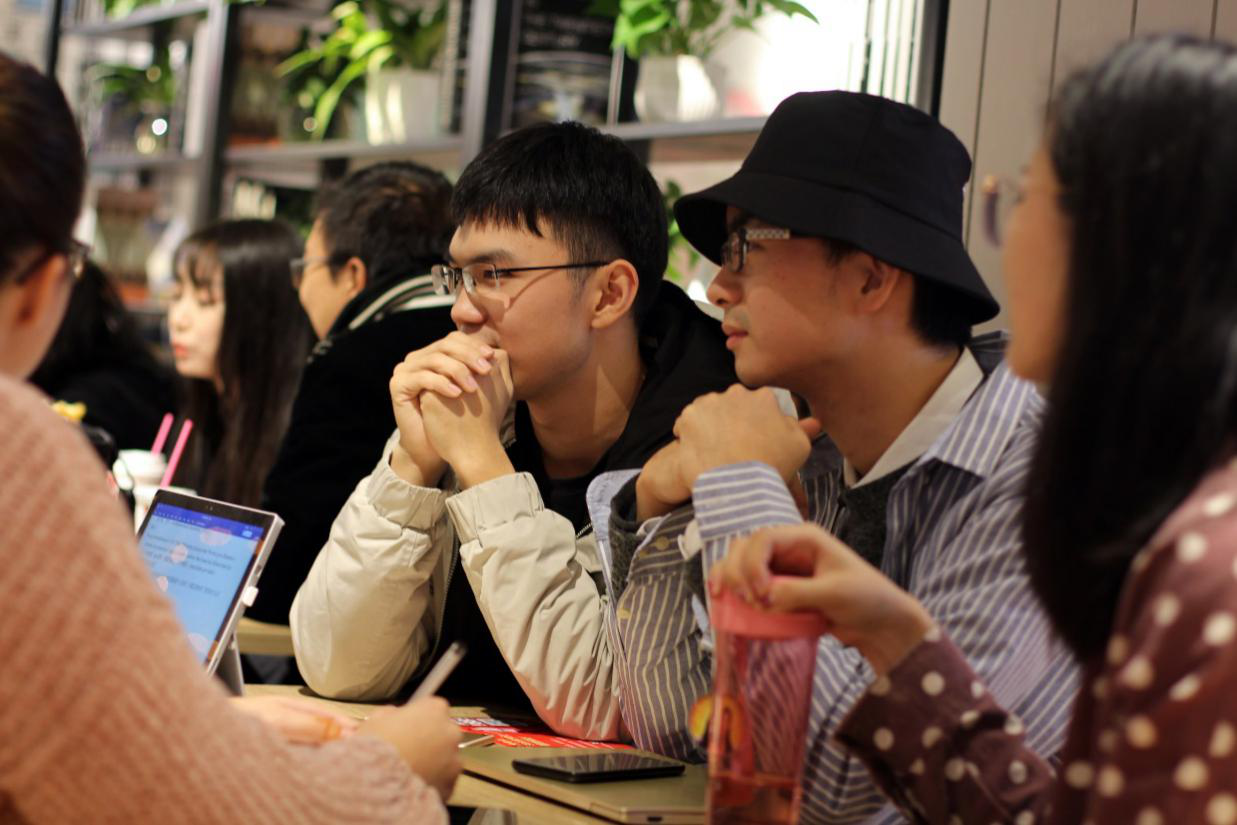Wuhan University is proud of its long history of cultivating the bright minds of the future. From October 24 to 28 , Chang Tianyi , Song Yifan, Tang Daijiao, Qin Yue, Liu Yuyan, Zhou Renjie, who are majoring in synthetic biology at Wuhan University, were the shinning stars at this year’s International Genetically Engineered Machine Competition (IGEM) in Boston, United States.

The team participating in the IGEM competition in Boston
Once the team finished the IGEM, they felt a huge ounce of relief—the university sponsored their attempt at success and the team did not disappoint the university. The competition put a lot of pressure on the team but they did their best to manage it. As Tianyi said, “everyone spared no effort to finish.” He was so excited at the time that he forgot to take a picture at the ceremony. When their professors heard of the team’s success, they were flooded with congratulations. “It’s an honor to have people whom you aspire to be then commend you on your contributions”, he said.
A judge commented the team as follows: “The team considered the actual application, identified the factors that would improve the survival of designed bacteria and utilized symbiosis and biofilm for that purpose. The team also consulted many resources available to them and learned from experts.”
Inspiration from protecting local environment
IGEM is the biggest competition in synthetic biology in the world which hosts more than 300 teams from over 30 countries. The students had a strong desire to participate in the prestigious competition, but they were not sure how to start.
They wanted to make a contribution to the scientific world but people do not simply tend to stumble on award-winning ideas. The students wanted to start close to home, thinking about issues that affect their daily lives. Wuhan University, located in the Wuchang district and hailed as one of the most famous and beautiful campuses in China, happens to sit next to the scenic East Lake.
On the surface, East Lake is beautiful, but inside it is like Snow White’s poisoned apple—not as perfect as it seems. Professor Xin Lu, who specializes in ecology, is really concerned with the university’s surrounding environment. His passion is one of the reasons that the team chose East Lake as their inspiration for this year’s IGEM. “In our talks the professor always nagged about the pollution problem in Wuhan’s East Lake,” said Chang, “he told us the water of the East Lake used to be so clear that many teachers and students came to swim in its waters. Nowadays, such scenes are rare because of the deterioration of the ecological environment and excessive sewage discharge.” A year later, five people who were part of that conversation joined IGEM and embarked on a project which aimed to improve water quality.
They designed a device which can float on the surface of water and use solar energy to collect and keep chemicals, namely phosphorus, like a “marine cage”. Once on shore, the chemicals can be extracted and disposed of if harmful or recycled back into the ecosystem if beneficial. It is indeed a potentially revolutionary way of recycling, for phosphorus can be used in agriculture and industry.

A blueprint of the device
The birth of “Noah’s Ark”
The team knew that the water quality in East Lake is at real risk of ecological destruction. They tested water and found it to contain a startling 7 times the normal amount of phosphorus which proves the occurrence of eutrophication in the lake. However, by doing some surveys in the local community, they realized that, although most participants were aware of the water pollution of East Lake, very few knew the cause of eutrophication or how to deal with it. In order to illustrate the pollution situation and introduce the idea of synthetic biology, theparticipants gave lectures in communities and schools, which also covered their project.

Yifan giving a lecture on synthetic biology in a community
Chemicals like phosphorous and nitrogen can act as useful materials but can also cause serious problems for the environment. At present, there is no effective way of disposing of these chemicals. Conventionally, the chemicals are exposed to activated sludge which they stick to and the mass is then buried underground. Using this method, the chemicals cannot be recycled and would pose a danger to the environment in the case of a leak.
The team aimed to identify a new way to tackle this problem. They termed these chemicals Coin Chemicals (CC) because they can do damage but also have the potential to be useful again, if collected and treated properly. The aim of the project is to minimize the adverse effects and, simultaneously, maximize the utilization of CCs.
So, how can they do that?
The device, which they named “Noah’s Ark”, has been carefully designed. The core part of the device is a bio-conveyor, made up of biofilm and a track. The biofilm functions as a multi-organism system in which bacteria and algae play a very important role. Two plasmids are transformed into bacteria in which the desired chemicals are collected which then form the biofilm. Since bacteria alone cannot survive and grow well in a sewage environment, the exopoly substance (EPS) excreted by algae can give bacteria protection and resistance to make them work well. In addition, algae can provide energy to the bacteria.

Interior structure and working mechanism of “Noah’s Ark”
Noah’s Ark is the device that can revolutionize the way we recycle chemicals in the environment and support our efforts to save the environment. The current device is supposed to target water contaminated by phosphorus. However, the secreting protein in the device can easily be replaced so that it could, hypothetically, target any chemical in the water. Thus, the device is sustainable because it is powered by a renewable energy source and has the potential to clean water supplies on a global scale. The greater the variety of chemicals it can collect, the cleaner our world’s waters could potentially become.
An arduous but fruitful journey
The team could not by themselves realize their invention. Although they knew how to manipulate the bacteria and algae to create a symbiotic relationship and how to gather the data, they were not sure how to analyze the data. This is where other universities came to help. Sun Yat-Sen University (SYSU) primarily aided the computer-based component of the research and guided the team on conducting the analysis. Huazhong Agricultural University assisted with the development of the light system that regulates how the bacteria-algae microorganism behaves. Huazhong University of Science and Technology (HUST) helped prepare the DNA sample for the research., Even Massachusetts Institute of Technology signaled their intention to help but the limited time did not allow for this to happen.
The co-leader of the team, Renjie, who is in charge of algae-bacteria symbiotic experiment, spent an entire month visiting the Hydrobiology Institute next to Wuhan University for face-to-face meetings. According to Renjie, this was the best way to communicate for the revision of the symbiotic system and the design of the device.
The journey has been an arduous one but that does not mean there was no fun. In September, days before the deadline, the team had their lucky escape and got some concrete data which proved their device worked. Until then, the team had been continuously working for half a year. The October, National Day holiday was for everyone but the team. They spent countless 10-hour work days in the lab trying to hash out all the bugs in the research. Some of them even slept in the lab for three, four, or even five days. With the final success, their efforts paid off.

Tianyi and Renjie conducting a molecular cloning experiment in MIT Biobuilder laboratory
During the intense competition, the team knew that they needed to persevere in order to taste the fruits of success. The competition is “not just a biology competition. In it you can develop other skills like talking to people, and learning to take feedback”, says Yuyan. They learned to tackle problem-based tasks, which is an unusual learning method to them. “Compared to a high school environment, where you are instilled with abstract knowledge, problem-based learning gets you to come up with your own solutions”, they say. The team persevered by “believing in their design, controlling their emotions, never giving up”, and finally achieved their goal.
Up until now, the team have completed the research and won the scientific community’s approval. However, they have not yet been able to turn their invention to reality. In future, they hope to create a prototype and, if funding is available, to make Noah’s Ark an invention of the present. The team is not sure how effective the device will be, “At the beginning of a new concept, stability is more important than efficiency.” They have completed the qualitative and quantitative testing but have not had real-life application yet. But just as they said, “the shining point of our journey hasn’t been application, but research.”

Tianyi, Renjie and Yuyan in the interview
Rather than scientists, the group of bright young people see themselves more as engineers. As Renjie says: “Scientists explore what we don’t know while synthetic biologists use what we already know and apply this to science. Synthetic biology is engineering; it identifies parts for new biological pathways that can then improve science.”
Edited by Li Yushan, Hu Sijia and Shi Weiya